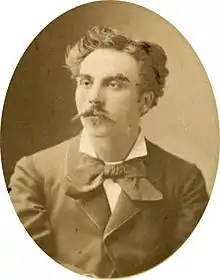Violin Sonata No. 1 (Fauré)
The Violin Sonata No. 1 in A major, Op. 13, was written by Gabriel Fauré in 1875 to 1876. It is considered one of the three masterpieces of his youth, along with the first piano quartet and the Ballade in F♯ major.[1]

History
The sonata was conceived in the summer of 1875 during a stay in Sainte-Adresse with the family of Camille Clerc, a prominent industrialist and supporter of his work, and completed in the autumn of 1876. Clerc, who had been on good terms with the renowned Leipzig-based publisher Breitkopf & Härtel, made considerable efforts to get Fauré's work published. However, Breitkopf & Härtel was only willing to publish the sonata if Fauré renounced his fee, a condition he accepted. The work was finally published in February 1877, just weeks after the premiere on 27 January 1877.[2]
The sonata was dedicated to his close friend Paul Viardot, the brother of Marianne Viardot, with whom Fauré was in love. The first recorded performance of the sonata took place on the eve of the premiere at the home of the Clercs, with Paul Viardot on the violin and Fauré himself playing the piano part. The private performance was met with lively enthusiasm.[2]
The premiere itself, at a concert of the Société Nationale de Musique in the Salle Pleyel, with young violinist Marie Tayau, was a great success, with the third movement having to be encored.[2] In a letter dated the same day, Fauré wrote: "The success of my sonata surpassed by far all my expectations!!! [...] As to my performer, I will never be able to express adequately how she made my sonata her own, how she put her heart and spirit into playing it. [...] Mademoiselle Tayau's interpretation was perfect."[2]
The premiere marked a turning point in Fauré's composing career, at the age of 31.[3] The work quickly found its way into the programmes of artists such as Benjamin Godard, Camille Saint-Saëns, Eugène Ysaÿe, Jacques Thibaud, George Enescu, Alfred Cortot and others. Writer Marcel Proust repeatedly paid tribute to the sonata in his novel In Search of Lost Time.[2]
Structure
The work consists of four movements. Despite its traditional structure – the first, second, and fourth movement being held in sonata form – the music is "confidently and profoundly individual".[4]
- Allegro molto (A major)
- The main theme of the passionate first movement enters immediately. After a brief dialogue between the instruments, a second theme is introduced in the violin, modulating over a rising chromatic bass. The themes are developed extensively, the second theme "floating ethereally above deep, hushed piano chords",[4] before finishing in a bold coda.
- Andante (D minor)
- The reticent slow movement begins in the rhythm of a barcarolle (9
8), the violin imitating the singing of a Venetian gondolier. The roles are then reversed, and a second theme in F major sparks a lively dialogue between the two instruments. A variation of the introduction returns, followed once again by the second theme, this time in D major, building to a climax "with astonishingly sonorous scoring".[4]
- The reticent slow movement begins in the rhythm of a barcarolle (9
- Scherzo: Allegro vivo (A major)
- Finale: Allegro quasi presto (A major)
- The dramatic and emotional finale begins dolcissimo on the violin, though it quickly transforms into the most energetic of the four movements, mesmerizingly oscillating around a recurrent C♯.[4] A second, strikingly syncopated theme breaks out in double stop octaves on the violin. In development, the first theme is obsessively worked against a new violin melody. The piece culminates in a brief majestic coda of pure virtuosity.
A performance takes approximately 25 minutes.[5]
Reception
Camille Saint-Saëns highly praised the work: "This sonata has everything that will seduce the gourmet: novel forms, exquisite modulations, uncommon tone colours, the use of the most unexpected rhythms. And hovering above all this is a magic which envelops the work and brings the masses of ordinary listeners to accept the wildest audacities as something perfectly natural."[6]
Today it is perhaps the most popular chamber music work by Fauré, cherished for its "freshness and verve, its characteristic Fauréan balance of elegant restraint and romantic ardour".[4]
References
- Nectoux, Jean-Michel (2001). "Fauré, Gabriel (Urbain)". Grove Music Online (8th ed.). Oxford University Press.
- Kolb, Fabian (2012). Preface to HN 980. Mainz: G. Henle Verlag. Retrieved 12 January 2021.
- Nectoux, Jean-Michel (1991). Gabriel Fauré – A Musical Life. Roger Nichols (trans.). Cambridge: Cambridge University Press. ISBN 978-0-521-23524-2.
- Wigmore, Richard (1999). Program notes to Hyperion recording CDA66277. Hyperion Records.
- Stevenson, Joseph. "Gabriel Fauré – Sonata for violin & piano No. 1 in A major, Op. 13". AllMusic. Retrieved 11 January 2021.
- Saint-Saëns, Camille (7 April 1877). "Une sonate". Journal de musique: 3.